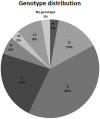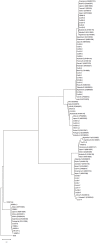Prevalence, risk factors and molecular characterization of Chlamydia trachomatis in pregnant women from Córdoba, Argentina: A prospective study
- PMID: 31150440
- PMCID: PMC6544222
- DOI: 10.1371/journal.pone.0217245
Prevalence, risk factors and molecular characterization of Chlamydia trachomatis in pregnant women from Córdoba, Argentina: A prospective study
Abstract
Background: Chlamydia trachomatis causes the most prevalent bacterial Sexual Transmitted Infection. In pregnant women, untreated chlamydial infections are associated with abortions, premature rupture of membranes, postpartum endometritis, low birth weight and transmission to the newborn. In Córdoba, Argentina, there is little knowledge about the prevalence of Chlamydia trachomatis in women in their third trimester of pregnancy, so, the aim of this study was to evaluate Chlamydia trachomatis prevalence and genotypes present in Cordovan pregnant women with different age and socioeconomic status.
Methods and findings: Design: prospective study. Settings: Women population from Cordoba city, Argentina. Population: Pregnant women having 35 to 37 weeks of gestation. Methods: Five hundred and nine cervical swabs were collected. Each sample was subjected to DNA extraction and PCR for Chlamydia trachomatis using primers NRO/NLO and CTP1/CTP2. Positives samples were sequenced to determine genotype. Main outcome measures: Demographic data of the patients were collected to detect a population at risk for this infection.
Results: A prevalence of 6.9% (35/509) for Chlamydia trachomatis infection was detected, with 32/295 and 3/214 from pregnant women with low or better economic resources respectively (p = 0,0001). Results showed a significantly increased rate of 11.6% (30/258) in women under 25 years compared with 2% (5/251) in patients over that age (p = 0,00003). Genotype E was the most prevalent.
Conclusions: With these results, we can say that pregnant women under 25 years old and low economic resources are one of the populations in which the screening programs of Chlamydia trachomatis should focus.
Conflict of interest statement
The specific roles of these authors are articulated in the ‘author contributions’ section. Susana Ruiz is an employee of Laboratorios LACE Sociedad Anónima (https://www.laboratoriolace.com.ar/). There are no patents, products in development or marketed products to declare, and this does not alter our adherence to PLOS ONE policies on sharing data and materials. All other authors declare that no competing interests exist.
Figures


References
-
- World Health Organization, Dept. of Reproductive Health and Research. Estrategia mundial del sector de la salud contra las infecciones de transmisión sexual, 2016–2021. 2016. http://apps.who.int/iris/bitstream/10665/250253/1/WHO-RHR-16.09-spa.pdf?....
-
- López-Hurtado M, Guerra-Infante FM. Papel de los anticuerpos en el desarrollo de la infección por Chlamydia trachomatis y su utilidad en el diagnóstico. Perinatol Reprod Hum. 2002; 16: 140–150.
-
- Murray PR, Rosenthal KS, Pfaller MA. Chlamydiaceae Microbiología Médica. 5° ed PA: Elsevier; 2006. 463–472.
-
- Eng T, Butler W. The Hidden Epidemic: confronting sexually transmitted diseases. Washington, DC: National Academic Press; 2003. - PubMed
Publication types
MeSH terms
Associated data
LinkOut - more resources
Full Text Sources
Medical

